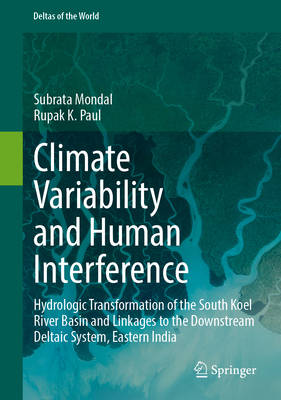
- Afhalen na 1 uur in een winkel met voorraad
- Gratis thuislevering in België vanaf € 30
- Ruim aanbod met 7 miljoen producten
- Afhalen na 1 uur in een winkel met voorraad
- Gratis thuislevering in België vanaf € 30
- Ruim aanbod met 7 miljoen producten
Climate Variability and Human Interference
Hydrologic Transformation of the South Koel River Basin and Linkages to the Downstream Deltaic System, Eastern India
Subrata Mondal, Rupak K PaulOmschrijving
This book presents a focused analysis of how climate variability and human activities reshape runoff behavior in the monsoon-influenced South Koel River Basin of Eastern India. Utilizing geospatial techniques, hydrological simulation (SWAT), and statistical analysis, it offers a rare empirical perspective on the hydrologic consequences of land use change.
It emphasizes the importance of examining the hydrological impacts of climate variability and human activities, addressing both global and regional concerns. Furthermore, it provides a comprehensive, state-of-the-art review of the topic, culminating in the identification of research gaps and outlining the scope of the present study to address them.
The present work outlines the geographical, climatic, and socio-economic context of the South Koel River Basin as the case study. It presents data sources, model framework (SWAT), and analytical tools used to achieve the book s objectives. Furthermore, this study examines historical changes in rainfall and runoff using the Buishand U Test, Buishand Range Test, Standard Normal Homogeneity Test, Pettitt Test, Mann-Kendall Trend Test, Modified Mann Kendall Test, and Sequential Mann-Kendall Test, identifying significant shifts over time and applies simulation-based method to separate and compare the impacts of climate variability and land use changes on runoff in the study area.
The analysis also assesses the sensitivity of land use and land cover components (forest cover, agricultural land, and urban built-up area) on runoff through one-way ANCOVA. Importantly, it extends the analysis to explore upstream downstream hydrologic connectivity, demonstrating how changes in the South Koel Basin influence the Brahmani Baitarani deltaic system through flow reduction, sediment deficit, and nutrient flux alterations. By situating the basin within its broader fluvial context, it underscores the indirect yet significant linkages between upstream transformations and delta resilience, drawing upon global and regional case studies to frame its implications.
This scholarly contribution concludes by summarizing key findings, providing scientific insights into runoff alteration mechanisms and basin-specific vulnerabilities, and recommending integrated water resource management strategies while identifying avenues for future research. By quantifying the comparative effects of climatic versus anthropogenic drivers, it offers a decision-support framework for sustainable basin and delta governance.
This volume is an essential resource for geographers, environmental scientists, and practitioners in water resource management. It is also useful for professionals working in the field of hydrology and related disciplines. Policy planners, decision makers, and stakeholders could benefit from the book. It is a good source of systematic guidance for postgraduate students and emerging researchers.
Specificaties
Betrokkenen
- Auteur(s):
- Uitgeverij:
Inhoud
- Taal:
- Engels
- Reeks:
Eigenschappen
- Productcode (EAN):
- 9783032132567
- Verschijningsdatum:
- 12/05/2026
- Uitvoering:
- Hardcover
- Formaat:
- Genaaid
- Afmetingen:
- 168 mm x 240 mm

Alleen bij Standaard Boekhandel
Beoordelingen
We publiceren alleen reviews die voldoen aan de voorwaarden voor reviews. Bekijk onze voorwaarden voor reviews.








